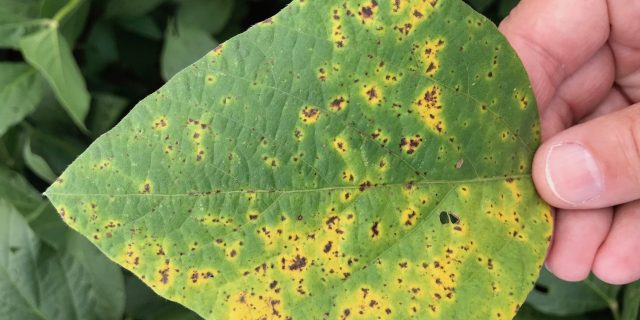22
Nov
Fungi that Survive Fungicide Use Multiply and Thrive

(Beyond Pesticides, November 22, 2022) Fungus that survive a fungicide application may be able to multiply and thrive, putting plant yields at risk. This finding comes from research recently published by scientists at University of Illinois, focusing on the impact of fungicide use on soybean yields and the disease Septoria brown spot, caused by the fungus Septoria glycines. The research underlines the danger of preventive chemical applications in an attempt to protect yield and shows how precarious pesticide use can be when subject to the complexity seen in field conditions.
Scientists began with the intent of analyzing the soybean’s phyllosphere mycobiome, the fungal microbial make-up of the outside of the plant, including all its surfaces above-ground. A field trial was established near Urbana, Illinois, and soybeans plants were separated into four different plots according to their treatment. One group was inoculated with Septoria glycines, another inoculated and sprayed with a fungicide, a third not inoculated yet sprayed with a fungicide, and a final control group neither inoculated nor treated with a fungicide. A range of different analyses were conducted to view changes in the disease development and mycobiome composition over time.
Soybean plants that had been inoculated with Septoria showed the greatest progression of the disease when compared to uninoculated plants. Prior to the fungicide application, scientists classified a range of fungal biota to determine a baseline of diversity, identifying over 3,300 distinct fungi on the soybeans analyzed. After fungicide application, scientists found results they did not expect. “When we applied the fungicide, most of the fungi on plant surfaces decreased,” said Santiago Mideros, PhD, study coauthor and professor at the University of Illinois. “But a few of the fungi increased, Septoria among them. It was very surprising.”
Scientists employed a mixture of the fungicides fluxapyroxad and pyraclostrobin, which are commonly used throughout the Midwest to manage fungal diseases in soybean crops. “We know – based on previous research – that when we spray a lot of fungicide, such as every week, Septoria symptoms are kept in check and yield increases,” Dr. Mideros said. “But that application frequency isn’t feasible for farmers. This study is a closer approximation of what producers actually do, with one to three applications during the season.”
The takeaway is to not proceed down the path of incessant preventive spraying but instead to reconsider the need for any pesticide application in the context of complex processes occurring on the leaf surface of soybean plants. “But what I’m learning from the study is that we don’t know exactly what we’re doing when we apply fungicides to protect yield. We need to learn more about the unintended effects of chemical applications.”
As the plants grew and fungicide applications occurred, scientists watched for changes to the phyllosphere mycobiome. While fungicides did change community composition, inoculation with Septoria did not result in significant changes compared to uninoculated plants. “One of the things we were trying to address with the analysis was to see which fungi are associated with each other,” Dr. Mideros said. “If we found patterns where one fungus seemed to have a suppressive effect on another, it could be used as a biocontrol agent. We did find some negative associations but not many and, unfortunately, none with Septoria. But there are several organisms that have a negative association with other fungi, so it’s something we could study further.”
Rather than use synthetic chemicals to suppress the growth of Septoria, scientists are aiming to develop biological controls that work with natural competition observed on plant surfaces. “There’s a lot of interest in finding more sustainable management practices. It could come in the form of biofungicides or manipulations of the mycobiome that could result in less disease and greater yields. There’s a world of hidden microorganisms associated with crops into which we could tap,” Dr. Mideros concludes.
Fungal pathogens represent a significant threat to crops and people. Researchers did not determine why Septoria persisted and thrived after fungicide application, but a reasonable hypothesis is that the pathogen has developed resistance to commonly used chemicals. The consistent, incessant use of fungicides in agriculture results in resistance in the field, but there is evidence that in certain fungi, this resistance is impacting our ability to address disease of public health concern. As the study shows, there can be thousands of different fungi on a plant. The repeated spraying of human pathogenic fungi in agriculture, particularly strains of Candida and Aspergillus, has been shown to lead to outbreaks in hospitals and other medical settings.
All unattributed positions and opinions in this piece are those of Beyond Pesticides.
Source: Agri-view, APS Publications
Photo Source: Alabama Coop Extension (photo of Septoria leaf spot on soybean leaf)










